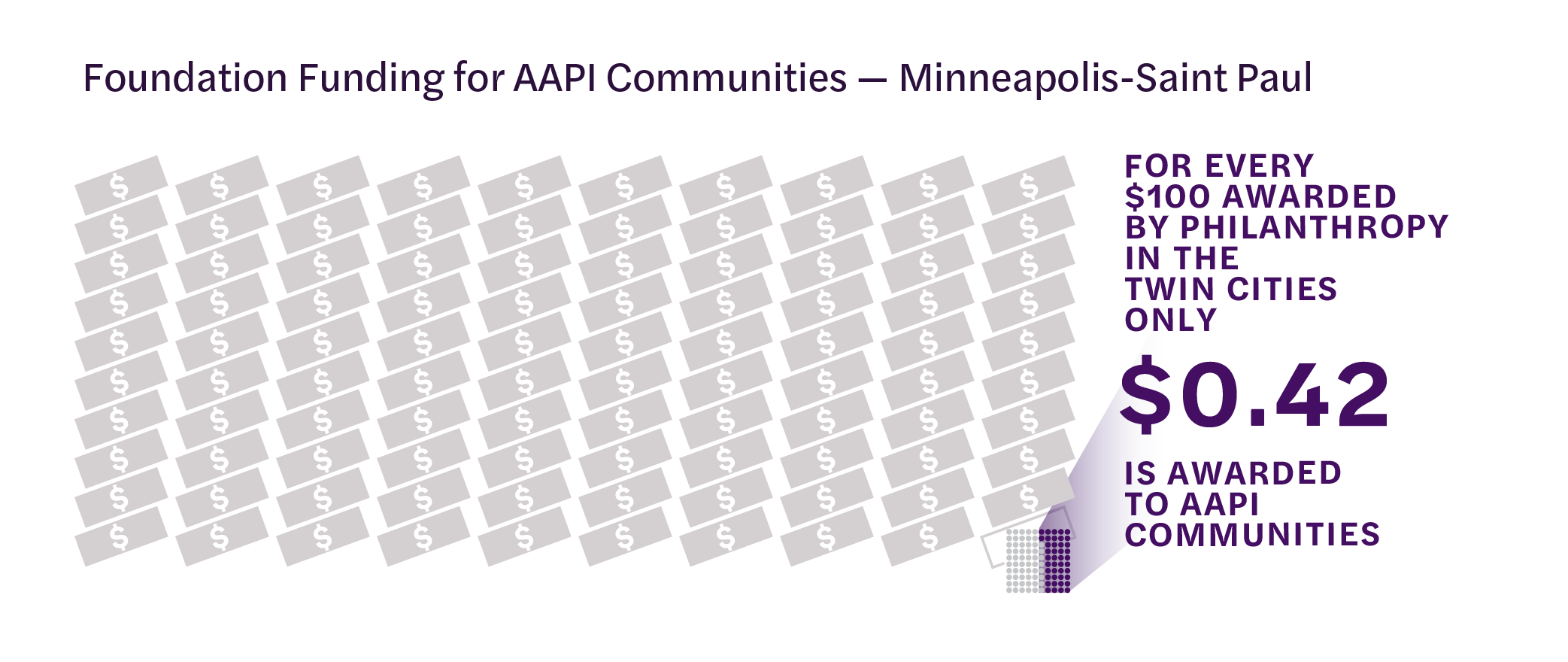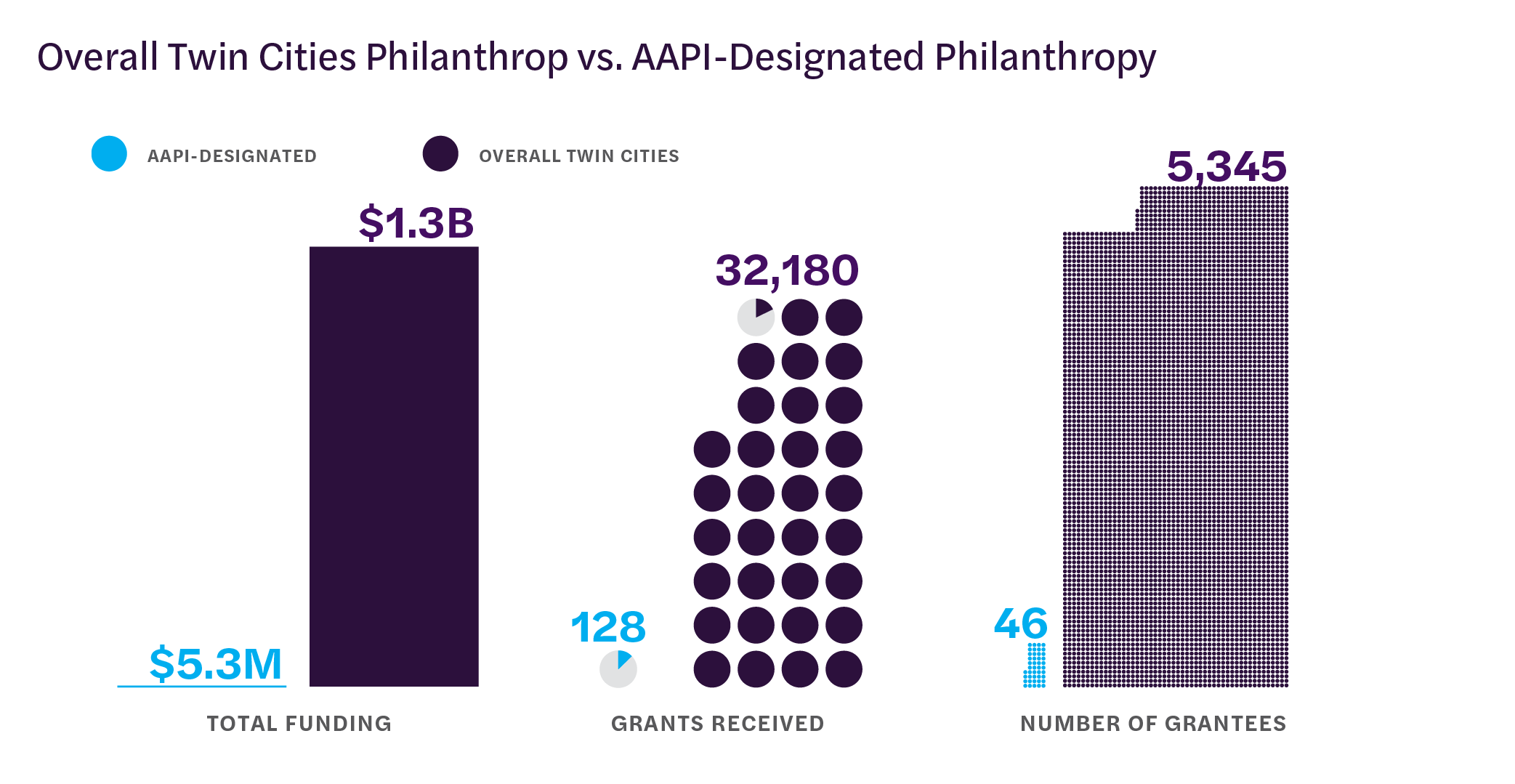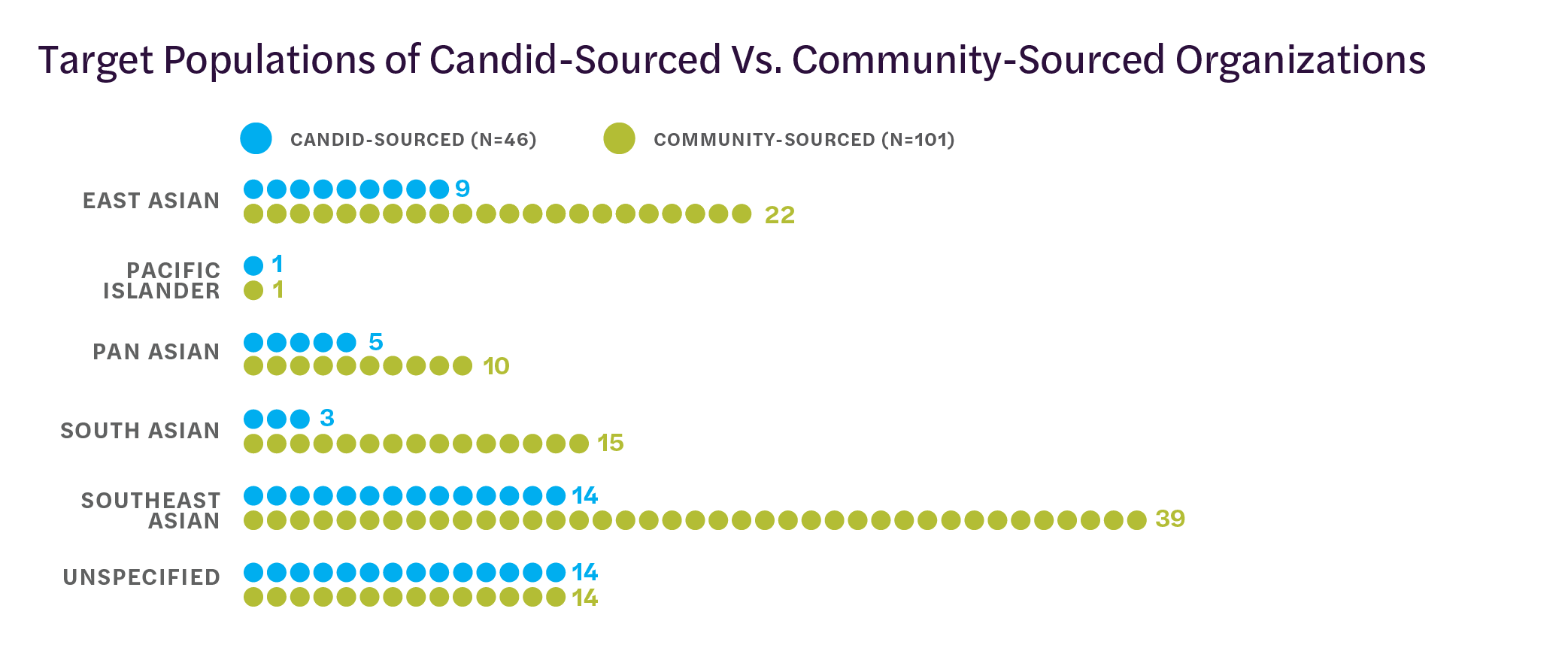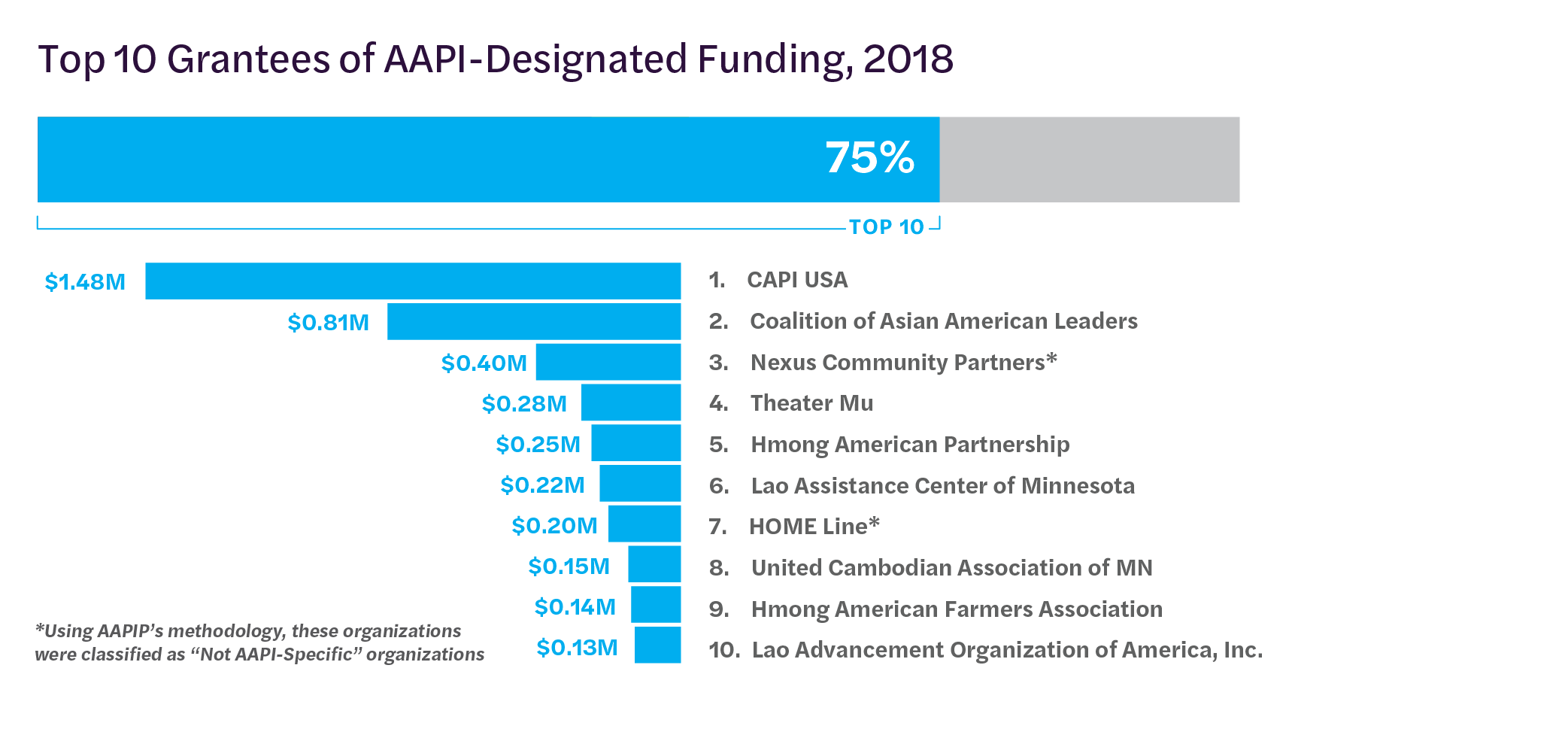Overview
The regional data on this page is excerpted from a new report: Seeking to Soar Regional Nonprofit Snapshot: Minneapolis-Saint Paul (Twin Cities). The analyses contained within this report were based on 2018 grant data. The ongoing COVID-19 pandemic has vastly impacted local AANHPI communities beyond what these analyses show.

Seeking to Soar REGIONAL NONPROFIT SNAPSHOT: MINNEAPOLIs-SAINT PAUL (TWIN CITIES)
The new AAPIP report finds that foundation funding designated for Asian American and Pacific Islander (AAPI) communities in the Twin Cities only accounts for 8.15% percent of all regional grantmaking.
Learn moreFunding Landscape and Community Ecosystem
The Minneapolis-Saint Paul area has a robust philanthropic landscape. While institutional philanthropy is only one part of the landscape, this report focuses on investments by institutional philanthropy due to the outsized role it plays in the funding of nonprofits with annual budgets of less than $2 million, which includes the majority of nonprofits in general and a disproportionately large share of nonprofits led by communities of color and other marginalized groups.

By all counts — total funding, number of grants, number of grantees, and average grant size (mean) — Asian American and Pacific Islander communities receive extremely low levels of institutional philanthropic support. The following charts are annotated with whole values, since the bar representing “AAPI” is hardly visible.
 More than 32,000 grants were made to an estimated 5,000 nonprofit organizations in the Twin Cities, of which only 128 grants were AAPI-designated to 46 organizations. The average Twin Cities grant size was 5.74x larger than the average AAPI-designated grant; $238,432 versus $41,490 respectively.
More than 32,000 grants were made to an estimated 5,000 nonprofit organizations in the Twin Cities, of which only 128 grants were AAPI-designated to 46 organizations. The average Twin Cities grant size was 5.74x larger than the average AAPI-designated grant; $238,432 versus $41,490 respectively.

AAPIP Classification: AAPI-Specific
Candid’s Philanthropy Classification System (PCS) includes a “check-all” option for coding populations. One limitation of this option is the inability to discern whether a grant is intended to serve Asian Americans, Native Hawaiian, and/or Pacific Islander communities, versus whether the grant is merely inclusive of AANHPI populations. AAPIP therefore refers to the organizations sourced from Candid’s Foundations Maps as “AAPI-designated” in both this report and in Seeking to Soar.
When a single grant is intended to serve multiple populations, particularly marginalized populations, there is the risk that these grants overstate philanthropic support and investment in these communities. Without finer details, these grants may even be double-counted or otherwise misrepresented. This is an additional reason why AAPIP advocates for greater disaggregation and tracking to organizations led by and for Asian American, Native Hawaiian, and Pacific Islander communities, as well as how much funding comes from AAPI-specific institutional donors.
While it may be possible that some grantees classified under “AAPI-designated” funding in the Candid Foundation Maps database include a significant portion of AAPI communities, AAPIP investigated further which of these grantees can be considered AAPI-specific. AAPI-specific organizations were classified based on whether their organization’s name, origin story, mission statement, or program description explicitly focused on AAPI communities and/or specific AAPI ethnic groups.
Whereas relying solely on the grant data that is inclusive of AAPI communities (Candid’s classification of “AAPI-designated funding”) creates a degree of uncertainty about what percentage is truly supporting AAPI communities, AAPIP’s classification of AAPI-specific allows for greater confidence that philanthropic funding to these grantees is serving intended communities and with greater cultural relevance.
In the figure below, organizations receiving AAPI-designated funding, as classified by Candid, totaled 46 organizations. Thanks to community partners such as the Coalition of Asian American Leaders (CAAL) and the Minnesota Council of Nonprofits (MCN), AAPIP was able to analyze an additional 101 community-sourced organizations. Deeper investigation to determine which organizations are “AAPI-Specific” revealed more than double the number of AAPI-Specific organizations beyond those in Candid’s database.

What is the Size of These AAPI-Specific Organizations?
An analysis of e-filed 990-series IRS filings for 2018 revealed that most Twin Cities AAPI organizations are small- to mid-sized. Of the organizations sourced by Candid’s Foundation Maps database, half of these AAPI-Specific organizations operate with annual budgets of less than $500K, and over 75% operate with annual budgets of less than $1M. Of the organizations sourced by the Twin Cities community, the vast majority of these organizations operate with budgets less than $500K; 33 of the 41 community-sourced organizations, or 80%, that filed Form 990s in 2018, in fact.

In addition to illustrating that the Twin Cities AAPI-specific organizations trend small- to mid-sized, the 990 analysis reveals the staffing needs of these critical organizations. Of the Candid sourced organizations, over 40% of these organizations have five or fewer staff, and over half of these organizations have 10 or fewer staff. Of the community sourced organizations, nearly 90% of these organizations have five or fewer staff! Many of these organizations rely on volunteer and/or part-time board members.

Who Are These AAPI-Specific Organizations Serving?
Of the organizations found in Candid, over 30% specifically serve Southeast Asian communities and nearly 20% serve East Asian communities. A handful of these organizations serve South Asian and Pan Asian (serve all people of Asian descent) communities. Only one Pacific Islander serving organization was identified from Candid’s Foundation Maps database.
Of the organizations sourced by the Twin Cities community, there were many more Southeast Asian, South Asian, East Asian, and Pan Asian serving organizations that were identified. In fact, thanks to the Twin Cities community, more than double the number of Southeast Asian, South Asian, East Asian, and Pan Asian organizations were identified. This is incredibly significant and continues to illustrate the importance of gaining a more expansive understanding of the local nonprofit landscape through community participation.

Who Are the Largest AAPI-Specific Organizations?
The Top 10 recipients of AAPI-Designated Funding received a total of $4.05 Million, accounting for over 75% (76.3%) of total AAPI-Designated funding.

Who Are the Largest AAPI-Designated Funders?
The Top 5 Funders of AAPI populations account for over 50% of total funding (50.7%). The Top 10 Funders of AAPI populations account for over 75% of total funding (76.2%).

Regional Recommendations
- EXPLORE THE LANDSCAPE OF SMALL ORG ANIZATIONSwhich make up the vast majority of AAPI-specific organizations (nearly 90% of the community sourced organizations have less than five staff). Consult and partner with giving circles and community leaders, or fund local community-based intermediaries to reach groups that traditional funders cannot serve well.
- CONSULT WITH AND COMPENSATE LOCAL AANHPI LEADERS to inform community investment strategies, including COVID-19 response, small business support, public safety, and mental health programs.
- PROACTIVELY RECRUIT AND SUPPORT AANHPI COMMUNITY LEADERS as board members, staff, and paid consultants to lead and inform philanthropic strategy. According to CHANGE Philanthropy’s 2020 Diversity Among Philanthropic Professionals (DAPP) Report, 4.7% of philanthropy staff in the Midwest identify as Asian American, with 6.3% identifying as Asian American or Multi-Racial (one of which is Asian).
- PROVIDE ADEQUATE GRANT FUNDING FOR STAFF POSITIONS that provide equitable compensation and benefits to ensure the sustainability and mental health of vital community leaders, especially leaders of color. Commit long-term, multi-year general operating dollars to AANHPI organizations, accelerating the cross-racial solidarity and intersectional work many AANHPI organizations are already doing, and promoting new opportunities for solidarity work between AANHPI organizations and other communities of color.
General Recommendations from Seeking to Soar
- SUPPORT the diverse needs of AAPI communities, while recognizing and building on their strengths.
- STRENGTHEN the capacity of AAPI organizations by providing multi-year, general operating support multi-year grants and promote the leadership bench for AAPI individuals.
- Take steps to INCREASE CULTURAL COMPETENCY OF YOUR FOUNDATION around AAPI communities, recognizing distinctions between American born and immigrant groups. Support Limited English Proficiency (LEP) populations through materials in multiple languages and provide access to interpreters.
- FUND NUANCED DATA COLLECTION EFFORTS for more community-based, quantitative and qualitative research that explores the lived experiences and diversity of AAPI communities.
- If your foundation produces issue-specific reports, USE DISAGGREGATED DATA TO LIFT UP AAPI COMMUNITIES needing support in areas such as poverty alleviation, immigration, criminal justice, education, seniors, etc.
- CENTER AAPI EXPERIENCES and fund front-line organizations led by and for those most impacted.
- USE TRUST-BASED PHILANTHROPIC PRACTICES to decrease the burden on leanly staffed organizations.
- INCLUDE AAPIS IN DISCUS SIONS OF RACIAL EQUITY AND STRUC TURAL CHANGE, whether about grantmaking or more generally, compensating them for their expertise where possible.
- ACCOUNT FOR IMPACT of gender, gender identity, and sexual orientation

Disaggregating racial data
AAPIP’s report Collective Good: Recommendations for Philanthropy on Racial Solidarity and Asian American, Native Hawaiian, and Pacific Islander Communities recommends the standardization and disaggregation of racial and ethnic categories in data collection and reporting to more accurately represent, better understand and partner with Asian American, Native Hawaiian, and Pacific Islander (AANHPI) communities.
Download the report